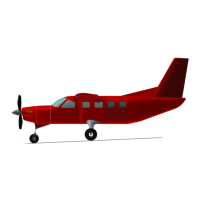HEATED STALL WARNING SYSTEM
The known icing stall warning system includes a lift transducer mounted on
the left wing, and a stall warning computer which is mounted overhead in
the forward cabin. The stall warning computer schedules the stall warning
to provide consistent warning margins to the stall regardless of ap setting.
This is accomplished by computer monitoring of the ap position signal.
The ap 0° setting is on one schedule and aps 10-35° are on a separate
schedule. This provides approximately 6 KCAS of stall warning margin at
all ap settings. In addition to the ap schedule for stall warning, there is
an offset for “ice mode.” The ice mode provides an additional stall warning
margin of 9-13 knots on top of the normal margins. The computer is placed in
ice mode when the left pitot heat is turned on. Any time there is ice adhering
to the aircraft, the pitot heat shall be turned on in order to provide the proper
stall warning margin. The stall warning system is heated to protect from ice
build up on the vane and mounting plate. The vane draws 20 watts of power,
the case heater draws 20 watts, and the mounting plate draws 18 watts
per square inch. The total power draw for the stall warning system heat is
approximately 240 watts.
If a failure is detected in the power to the stall warning heaters, the following
annunciation is shown:
STALL HT FL
LOW / HIGH AIRSPEED CAUTION SYSTEM
This system is equipped with an airspeed caution system to alert the pilot
when airspeed is outside the designed operating envelope with the ice
protection system operating in any mode (NORM, HIGH, MAX, or BACKUP).
Cautions are provided when the airspeed is less than 110 KIAS, greater than
168 KIAS, or greater than 190 KTAS. The low speed caution is shown on
the PFD as:
LO ICE SPEED. The high speed caution is shown on the PFD
as:
HI ICE SPEED.
To prevent nuisance alerts during takeoff and landing, the low speed alerts
are inhibited during the following conditions:
• Inhibited while the aps are extended for takeoff (10 or 20°) and for 1
minute after takeoff. This 1 minute of time is to allow for the transition
from takeoff to enroute climb and exiting of the airport environment.
• Inhibited while the aps are extended for approach and landing (10
or 20°). A minimum airspeed of 85 knots shall be used while in this
conguration, but no low speed caution will be provided.

